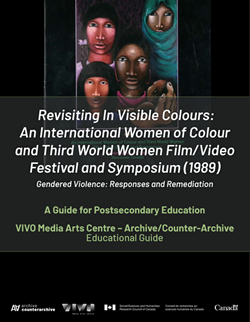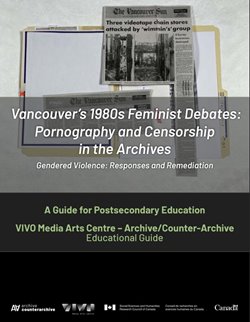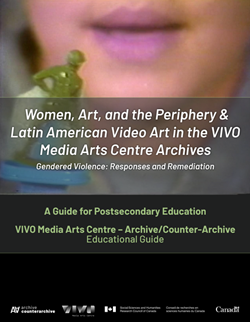Click here to access the educational guides and stream the films on VUCAVU.
Read below to learn more about our collection of educational guides for the "Gendered Violence: Responses and Remediations in the VIVO Media Arts Centre" Case Study.
VIVO Media Arts Centre is located on the unceded territory of the xwməθkwəy̓əm (Musqueam), Skwxwú7mesh (Squamish) and səl̓ílwətaɬ (Tsleil-Waututh) First Nations. Incorporated as Satellite Video Exchange Society in 1973, VIVO Media Arts Centre is a steward of critical history and an agent for emergent experimental media arts practices. Through its activities and extensive archival resources, VIVO plays a unique role in facilitating and fostering artistic practices in the region. VIVO's programmes—including workshops, production support, distribution, artist residencies, performances, and exhibitions as well as curatorial and archival research—foster formal and critical approaches to media arts, and reflect the diversity of contemporary technologies and communities that coalesce around new forms of knowledge and creativity. The Crista Dahl Media Library & Archive (CDMLA) at VIVO stewards a significant repository of videotapes by artists and independent producers. Spanning over 50 years of production, its nearly 8,000 media works reflect the complexity of video art history.
The VIVO Media Arts Centre Case Study activated three archival collections held at VIVO’s Crista Dahl Media Library & Archive that focus on the subject of gendered violence as it was discussed, debated, and exhibited in and around Vancouver in the 1980s. Although united by a common theme, these collections span a variety of topics: the 1989 In Visible Colours film and media festival which aimed to foreground discussions of settler colonialism, decolonization, indigeneity, and solidarity; feminist porn wars and resistance to censorship; and, activist video responses to the Pinochet dictatorship. Taken together, these three collections generate intersectional and multigenerational dialogue about gendered violence; as such, the films and videos in this archive are modes of creative resistance against several forms of subordination and oppression.
In partnership with VIVO Media Arts Centre, the Archive/Counter-Archive project has developed three educational guides that engage with each collection as part of its Gendered Violence: Responses and Remediations Case Study. Each of the guides is outlined below.
Please click on the links below to access each of these guides and their film programmes on VUCACU.com:
- Revisiting In Visible Colours: An International Women of Colour and Third World Women Film/Video Festival and Symposium (1989). Curated by Ana Valine and Roya Akbari. [$10]
- Vancouver’s 1980s Feminist Debates: Pornography and Censorship in the Archives. Curated by Ana Valine. [Free]
- Women, Art, and the Periphery & Latin American Video Art in the VIVO Media Arts Centre Archives. Curated by Roya Akbari. [$10]
Gendered Violence: Responses and Remediations: Revisiting In Visible Colours: An International Women of Colour and Third World Women Film/Video Festival and Symposium (1989)

Drawing on two collections from the CDMLA—the Women In Focus Society (WIF) fonds and the Satellite Video Exchange Society (SVES) fonds—this educational guide centres on the history and archives of In Visible Colours: An International Women of Colour and Third World Women Film/Video Festival and Symposium (IVC), cofounded in 1989 by Zainub Verjee and Lorraine Chan in partnership with Women in Focus and National Film Board. With over 100 films and videos from 28 countries, In Visible Colours emerged amid the sociopolitical upheaval of the late 1970s and 1980s that foregrounded race and gender and the politics of cultural difference.
This guide also draws from In Visible Colours: Remediated 2022, a symposium that brought together some of the original participants of IVC along with students, researchers, curators, and contemporary producers. The event was organized in collaboration with VIVO Media Arts Centre, Archive/Counter-Archive, the Vulnerable Media Lab, and the Screen Cultures & Curatorial Studies graduate programme at Queen’s University. The City of Vancouver Archives generously shared audio recordings of the original 1989 panels with the CDMLA for inclusion in the archive and the 2022 remediation.
This guide includes a selection of three films and videos curated by Roya Akbari and Ana Valine. It includes a curatorial essay by Roya Akbari, synopses, and discussion questions oriented toward a range of thematic areas. We recommend previewing the works before you screen them for your students and reading the contextualizing information provided in this guide. Please note that some of these videos contain distressing themes.
Gendered Violence: Responses and Remediations: Vancouver’s 1980s Feminist Debates: Pornography and Censorship in the Archives

Drawing on two collections from CDMLA—the Women in Focus Society (WIF) fonds and Sara Diamond fonds—this educational guide centres on the feminist debates regarding issues of pornography and censorship that took place in Vancouver in the 1980s. Indeed, during this time, many Vancouver feminists opposed to porn drew on the language of gender violence to make their case, arguing that all sexually explicit images of women were harmful. Working against this position and the creep of censorship into smaller moving image formats in the province, queer and feminist artists defended sexual expression and created alternative visual languages for sex.
In particular, this guide expands on the 2022 mail-art project developed by Vancouver-based artists Hazel Meyer and Cait McKinney in collaboration with VIVO and Archive/Counter-Archive entitled The images, such as they are, do have an effect on us.
The guide features images and videos documenting Meyer and McKinney’s mail art project, an essay by Ana Valine on the feminist debates regarding sexual representation and censorship in the 1980s, and contextualizing images and videos. The curated material is listed in the suggested order of viewing and a list of discussion questions is included to encourage conversation. We recommend previewing the works before you screen them for your students and reading the contextualizing information provided in this guide. Please note that some videos contain graphic imagery.
Gendered Violence: Responses and Remediations: Women, Art, and the Periphery & Latin American Video Art in the VIVO Media Arts Centre Archives

Drawing on the Satellite Video Exchange Society fonds (SVES) at the CDMLA, this educational guide centres on Women, Art & the Periphery (WAP), a series of multimedia events conceived and curated by artist and academic Sara Diamond in 1987 which featured contemporary art by Chilean women. It also draws from the 2023 revisitation of WAP, Latin American Video Art in the VIVO Media Arts Archives, curated by media artist and cultural historian Gabriela Aceves Sepúlveda. Taking the documentation of Women, Art and the Periphery as a point of departure, this recent event featured a screening and library showcasing a selection of Latin American video, audio, and archival documentation from the CDMLA to celebrate the launch of Encounters in Video Art in Latin America, edited by Elena Shtromberg and Glenn Phillips (Getty Research Institute, 2023).
This guide includes a curatorial essay by Roya Akbari, a list of five videos suggested for classroom viewing, synopses, and discussion questions oriented toward a range of thematic areas. We recommend previewing the works before you screen them for your students and reading the contextualizing information provided in this guide. Please note that some of the works involve nudity and sexual innuendos.

